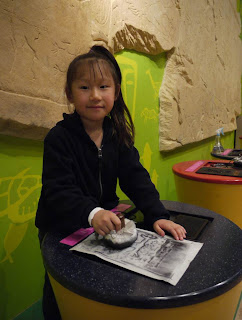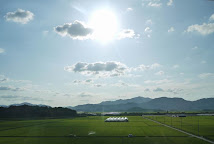Deb and I have visited the museum a couple of times already, spending a couple of mornings while the girls were at school, touring the archeology and history sections. We thought it would be a good introduction to Korean history and give us some context for when we head out to tour the country later during our trip.
In addition to housing national treasures, the National Museum is an amazing structure itself and is set on beautiful grounds littered with historical artifacts (pagodas, statues, stele and placenta tombs....more about those later). It took 8 years to build and was only recently opened. The other really good thing about it, is that admission is free!


View across reflecting pond of main building. Students waiting to enter main entrance.


View from main entrance south to apartment buildings of Ichon. Inside main entrance rotunda.


The central hallway of the main building is a huge marble clad structure with a few large stone artifacts, including this ten storey stone pagoda, National Treasure No. 86, originally erected in 1348 (and recovered from the Japanese after World War 2).
History of a place needs geographic context, so appropriately enough the first exhibit is a map of the world with Korea circled in red. There were many displays through the museum with time/event charts showing not only what was happening in Korea at a given time, but also the main historical events in China, Japan and the rest of the world. Here Deb is pointing out one to Jin.


There is evidence of human habitation on the Korean peninsula as early as 700,000 years ago during the Paleolithic period. These early artifacts are mostly stone impliments (axes, spear and arrow heads, etc.). Pottery making began in the Neolithic period about 10,000 years ago in Korea. Around 3000 years ago the Bronze Age arrived and from then on it was swords, shields, armour, armies, wars, kingdoms, invasions, occupations, wars for independance and of course the Korean War in the 1950's. Metals like bronze, then iron also allowed the development of better tools, farm implements and other everyday items. Also money, jewellery, crowns, and some spectacular works of art. And of course there is a long history of Buddhism, Confucianism and Taoism in Korea, as well as printing with metal type, the development of Korean alphabet and lots more. There are also the interesting and varied relationships Korea has had with its neighbours, China and Japan. This country is loaded with history! Here are a few things that caught our eyes in the museum.
Here Deb is admiring stone daggers, swords and other implements of war. On the right is a nice display, including a stringed musical instrument from the 1st century CE.


One of the most beautiful things we saw was a gilt-bronze incense burner dating from the Baekje period over 1300 years ago. It was only discovered in 1993. My pictures of the original didn't turn out, so here is a photo of a replica in the Children's Museum. Beside it is a crown (brass I think) that dates from the Goguryeo period (between 100 and 300 CE).
The other awesome artifact we saw was a 5th century (Silla Three Kingdoms) gold crown and belt, adorned with curved jade pieces. This piece had its own room.


Here are a couple of mean-looking little warriors and an armoured warrior from another era.
Many of the artifacts in the museum were found in tombs like those beneath the burial mounds in the photo below. Mounds like these are apparently quite common and we hope to see some as we tour the countryside later this summer. In some places people were buried in earthen jar coffins, like this unusually large one. Lili thought it was a giant peanut!




In the late 15th Century King Sejong commissioned the development of a Korean alphabet, called Hangeul. Up until then they had used Chinese characters. Chinese was used for a long time afterward, especially for official business, and Chinese characters are sometimes used today. Hangeul was developed as a simpler system that enabled wider literacy across all classes of society. Here Deb is studying the basic alphabet of 24 characters. The photo on right shows the 11,172 possible Korean syllables formed with these letters - each syllable is comprised of 2, 3 or 4 characters (consonant-vowel; consonant-vowel-consonant; and, a limited number of consonant-vowel-consonant-consonant). Below is a close up of part of this list of syllables and to the right a folding book printed around 1440.


Another section of the museum that we found interesting was the one on map making. This dated from only the last few centuries, but was amazing in its detail an interesting in its perpsective (Korea or Asia centric). Here (below) are examples of a section of a map printed around 1860 and the block used to create it.
On weekdays the museum is swarming with hundreds (maybe thousands?) of school children from all over the country. They got a kick out of saying "hello" to us and a great giggle when we responded, sometimes with questions of our own. Sometimes a group of them would push the best Englsh-speaker forward and get him or her to ask us where we were from, what our names are and sometimes even how old we are. It was fun. Above is a troop of kindergarten students wandering around among the pagodas in the beautiful museum grounds.


Koreans developed the worlds first movable metal type around 1230, more than 200 years before Gutenberg developed his famous metal printing technique. Below left is an example of metal type and a book printed with metal type in 1718. Printing had been done with wooden printing blocks long before this. In fact the museum has a replica (photo below right) of the oldest wooden block print in existence, an 8th Korean Buddist scroll called Pure Light Dharani Sutra.
Another section of the museum that we found interesting was the one on map making. This dated from only the last few centuries, but was amazing in its detail an interesting in its perpsective (Korea or Asia centric). Here (below) are examples of a section of a map printed around 1860 and the block used to create it.
And here is a reproduction of the whole map imbedded in the floor and examples (on the wall) showing the evolution of map making in Korea.
On weekdays the museum is swarming with hundreds (maybe thousands?) of school children from all over the country. They got a kick out of saying "hello" to us and a great giggle when we responded, sometimes with questions of our own. Sometimes a group of them would push the best Englsh-speaker forward and get him or her to ask us where we were from, what our names are and sometimes even how old we are. It was fun. Above is a troop of kindergarten students wandering around among the pagodas in the beautiful museum grounds.
The museum is an awesome and informative place to go. We now feel better prepared to tour the country armed with at least a little more knowledge of the long and fascinating history of this country. We will have to go back to the museum again, there lots more more to see! Maybe our next rainy weekend. Here is the website of the museum:
I'll leave you with a photo of a womb tomb, where Joseon royalty would store the placenta and other related bits from a newborne royal baby. Interesting.....not sure why, but we'll look into that and get back to you about it.
Bye for now,
Derek, Deb, Jin and Lili































Jin and Family
ReplyDeleteWow what a great experience for everyone...The pictures are awesome. I am jealous and sure that everyone is having such a great time. What a wonderful experience for everyone...I am really enjoying all of the beautiful pictures and all of the history behind everything you are all seeing. Have a great journey and God Bless all of yo and keep you safe. Everyone at school say hi and send their best wishes to all of you. Madame Langille
Derek, Deb, Jin and Lili,
ReplyDeleteWhat a great travel blog! Sure looks like you are all having an awesome time. Can't wait for your next post. Marg R.
Hello Jin and Family
ReplyDeleteTook the students to the computor lab on Monday and the grade 6 students read the grade 1 students all of the updates.They were really thrilled to find out all of the great things you are doing and seeing. Unfortunately when they tried to post a comment it would not open up for them to write anything. Anyways they all say hello and know you are having a great experience. We received your postcard today May 27th, and I read it to the class. They all say hello and we posted the card on the door of the classroom. It's been really cold here lately and we hope it will warm up soon. Can't believe that the year is almost over. We will look forward to the next posting. Madame P. Langille